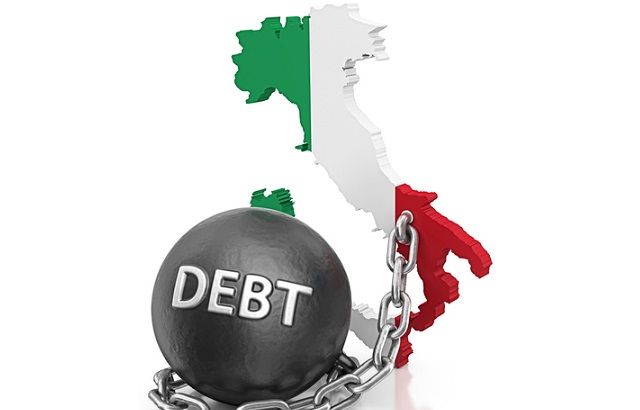Italy’s high debt levels, fiscal slippage and policy uncertainty have recently contributed to concerns on the country’s debt sustainability.
The size of Italy’s economy – the third largest in the eurozone – and its interconnectedness with core euro area member economies elevate the country’s systemic relevance for the monetary union.
The country’s populist coalition government – led by the anti-establishment Five Star Movement and the far-right League – has repeatedly clashed with Brussels over its spending plans amid concerns over the country’s vast debt burden.
Italy’s 132% debt-to-GDP-ratio is the second-highest in the eurozone and contravenes EU budget rules.
Rome avoided European Commission sanctions this month over its public debt, after promising to trim its budget deficit over the next two years, but the dispute is likely to flare up again.
The relationship between League leader prime minister Matteo Salvini and deputy prime minister Luigi Di Maio from Five Star has soured, meanwhile, fuelling concerns the coalition could collapse.
Spillover risks
Spillovers from an Italian debt crisis to other euro area economies could emerge from at least three sources, according to an analysis by Berlin-based ratings group Scope.
- The non-financial debt channel (via Italian public and non-financial private debt held by euro area institutions outside of Italy)
- The banking channel (financial risk resulting from the interconnectedness of euro area banks)
- The real-economy channel (risk contagion via trade and other economic inter-linkages)
“Until now, we have observed little risk spillover from Italy to major financial institutions in the rest of the euro area,” said Bernhard Bartels, associate director in the public finance team of Scope Ratings.
“However, given that almost half of Italian public and private non-financial debt in banks is held by global systemically important banks, risk of more widespread contagion is non-negligible if the Italian crisis were to escalate in the future.”
Italy stands out among euro area countries because of the degree of home bias in the holders of its debt: more than 66% of Italian sovereign debt is held by domestic creditors, compared to 51% for German and 47% for French debt.

According to the EU-wide stress test conducted by the European Banking Authority and published in 2018, Italian banks held roughly €800bn in Italian public and non-financial private debt as of December 2018, equal to 41.1% of total assets. Italian public debt totalled 9.2% of Italian bank assets alone.
“This results in an especially strong sensitivity of Italian banks to Italian public-finance risk, as euro area banks’ cross-border activities decreased after 2008 from low pre-crisis levels and have only gradually recovered since then.”
“Italy’s economy remains mainly reliant on domestic credit, which makes it vulnerable to a sovereign debt crisis – given the exposure of domestic banks to Italian public debt securities – meaning any sovereign crisis can quickly result in a credit crunch and a broader economic crisis,” Bartels said.
The interdependence between domestic banks’ balance sheets and the sovereign’s public finances generates substantial risks for domestic financial stability but this matters for the entire euro area, given Italy’s economic size and deep trade integration in the euro area.
“Learning from the experience with Italy – including issues of the sovereign-bank doom loop, several proposals have been made by academics to complement EU rules via instruments that would restore fiscal accountability and enhance banking system resilience,” Bartels noted.

Risks stemming from the ties between the Italian economy and other European economies are significant. Intra-euro area trade in 2018 accounted for 41% of Italy’s goods exports and 47% of goods imports. Italy is deeply integrated economically and remains an important import destination and contributor to the supply chains of major industries across Europe.

Curtailing eurozone risks
According to Scope, three of the ideas put forward by the Centre for Economic Policy Research could curtail the sovereign-bank nexus and enhance the resiliency of the euro area to sovereign crises:
- The introduction of risk weights for sovereign debt and/or;
- A limit on bank holdings of the same country’s sovereign bonds; and
- The creation of a European safe asset.
If EU fiscal and bank governance institutions were complemented by implementing a combination of these proposals, this could strengthen the currency union in at least three dimensions:
- Re-establishment of fiscal accountability at the national level leads to greater market discipline, thereby increasing the resilience of the euro area to country-specific shocks;
- Less spill-over from instances of fiscal distress to private sectors, reducing the sovereign-bank nexus; and
- Improved resilience of banking sectors through more diversified sovereign risk portfolios and risk weights that more accurately reflect sovereign risk.
The transition to risk-weights and/or domestic sovereign debt limits alone entails risk to the financial stability of countries like Italy during any phase-in period, according to Scope.
This is true for economies whose banks would be either forced to raise additional capital and/or to sell part of their domestic sovereign bond holdings.
This in turn could lead to the sovereign-bank crisis that the proposal was intended to prevent in the first place if not managed carefully. The parallel introduction of a safe bond, as such, could help provide the additional demand needed for the excess supply of government debt resulting from the limits/risk-weights, in the process facilitating greater euro-wide sovereign debt diversification on bank balance sheets.
“In the case of Italy, public debt sustainability remains a major challenge in view of the policies being implemented by the current government. This in turn could present greater implications for the rest of the euro area if investors were to question the stability of the currency union. Here, adoption of the three above proposals could help reduce the doom loop and support all euro area sovereign ratings in the long-run, not only that of Italy,” the Scope paper concluded.







